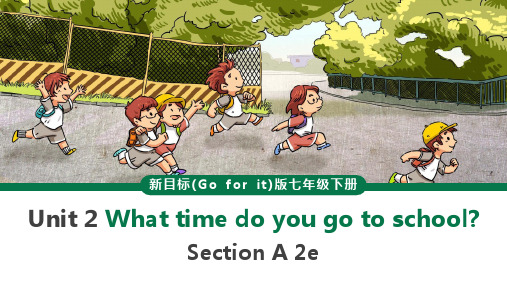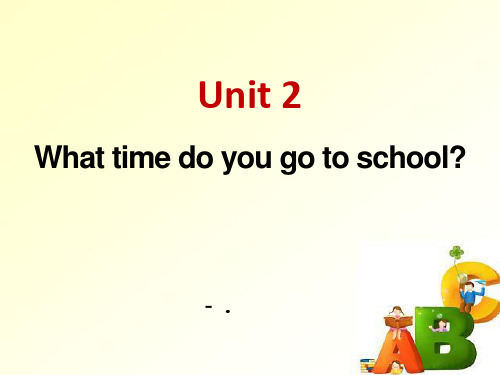人教新目标七下英语U2What time do you go to school SectionA第二课时
- 格式:ppt
- 大小:5.02 MB
- 文档页数:31

T eaching PlanUnit2What time do you go to school?SectionA1a-2dⅠ.Language goals:1.V ocabulary:dress,up,brush,tooth,shower,usually,early,station,funny,exercise2.Phrases:g e t up,dr essed up,g e t dressed,brush the teeth,take a shower,radiostation,eat breakfast3.Sentences and structures:-What time is it?-It’s…T eaching goals: T eaching important points:-What time do you usually…?-I usually….-What time d o es h e/sh e usually…?-He/She usually..(s/es)….II.Ability goals:1.T alk a bo u t routines;Ask a bo u t and say times.2.Improve the abilities of listening,speaking.3.Learn t o use the phrases and sentences of this part.III.Emotion goals:T o understand the importance of the time and making full use of time1.New words and expressions in this part.2.The routinesT eachingdifficult points:S tudents can talk a bo u t their routinesT eaching approaches: Learning T ask-based Language T eaching speaking,listeningapproaches:T eaching procedures:T eaching contents and the teacher’s activities S tudents’activitiessS tep One: Greeting1. Greet the students warmly ..2. Enjoy a son g abo u t the clock. S tep Two: Talk about time1. T: What time is it? S: It ’s eight o ’clock. (Ask several students a bo u t time.)2. Ask one student to be a clock and show us the time. S tep Three: Presentation1. -What do you usually do at 6:30? S: I usually …at …-What do I usually do at 6:30? Listen and guess. - Brush the t eethMotivate students t o g et into the class quickly.Use the new phrases to mak e sentences.2. Guess my morningListen and guess what I usually do in the morning.(get up, go t o work, g e t dressed, brush the teeth, take a shower).3. R ead the phrases loudly and r e me mber them. S tep Four: PairworkA: What time do you usually…?B: I us ually… at….Work in pairs and gr oups S tep Five: Groupworkt o practice the dialogueA: What time does he/she usually …?B: He/She usually –(s/es) up at…. S tep Six: Oral English1. I talk about my morning and then I ask students to talk about their own morning.I g e t up at 6:30. I brush my teeth at 6:35. I take a shower at 6:40. I eat breakfast at 7:00. I g e t dressed at 7:20. I go to work at 7:30. 2. Ask student to talk about Mrs W ang ’morning. Mrs Wang gets up at 6:30. She brushes the teeth at 6:35. She takes a shower at 6:40.She eats breakfast at 7:00. She getsdressed at 7:20. She g o es t o work at 7:30. S tep Seven: Listening practice1. Listen and mat ch the times with the actions. Draw lines from the clocks t o the pictures. (1b)2. Listen to the conversation. Complete the sentences.(2a)3. Listen again. Complete this shower schedule for Jim’s family.(2b)S tep Eight: ConversationS tudents can use the important sentence pattern to talk a b o u t their own morning and other ’s morningListen and fill in the blanks1R ead the conversation in2d loudly and quickly,then fill in the Discussion blanks.2.Role-playAsk two students t o imitate2d t o have an interview.Then show us it.Step Nine:Homework1.Make a survey with the drill“What time do e s your father/ mother g e t up/take a shower…?2.Design(设计)your ideal(理想的)day!Proverbs:•Time is life.R ead the conversation and give students the performanceR emember the importance of the time•Time is money.•All time is no time when it is past.•Every second counts.Unit2What time do you go to school?1.--What time do you usually ge t up?--I g e t up at6:30.2.–What time d o e s he/sh e usually g e t up/…?--He/She gets up at6:30.gets dr essedeats breakfastg o e s to workbrushes the t eeth。

人教版新目标英语七年级下册《Unit 2 What time do you go to school》优质教学设计2一. 教材分析人教版新目标英语七年级下册《Unit 2 What time do you go to school》主要介绍了日常生活中的时间安排,包括起床、吃早餐、上学、放学、做作业、娱乐等活动。
本节课主要让学生学会询问和回答别人日常活动的时间,并能够用英语描述自己的时间安排。
教材内容贴近学生生活,有利于激发学生学习兴趣,提高学生英语表达能力。
二. 学情分析七年级的学生已经掌握了基本的英语语法和词汇,具备一定的听说读写能力。
但部分学生对英语学习仍存在恐惧心理,缺乏自信心。
此外,学生在生活中对时间的认识和安排各有不同,需要教师引导学生逐步养成良好的时间管理习惯。
三. 教学目标1.知识目标:学生能够掌握日常活动词汇,如sleep, wake up, get up,go to school等;学会用What time do you go to school?询问别人日常活动的时间,并能用英语描述自己的时间安排。
2.能力目标:学生能够听懂、会说、会读、会写日常活动相关的句子,提高英语表达能力;学会用英语询问和回答别人日常活动的时间。
3.情感目标:培养学生珍惜时间、合理安排时间的意识,养成良好的时间管理习惯。
四. 教学重难点1.重点:学生能够运用所学词汇和句型询问和回答别人日常活动的时间。
2.难点:学生能够用英语描述自己的一日生活,并在实际情景中灵活运用所学知识。
五. 教学方法1.任务型教学法:通过设定各种实际情景,让学生在完成任务的过程中运用所学知识,提高语言实际运用能力。
2.情境教学法:创设生活情境,让学生在真实的环境中感受和体验英语,激发学习兴趣。
3.激励性评价:注重鼓励学生,提高学生自信心,激发学生学习积极性。
六. 教学准备1.教材:人教版新目标英语七年级下册《Unit 2 What time do you go to school》。


Unit 2 What time do you go to school?必背短语get up 起床 get home到达家中 get to work到达工作岗位 make breakfast做早饭make a shower schedule做一个洗澡的安排 practice guitar 练吉它 leave home 离家take a shower = have a shower 洗淋浴澡 take the Number 17 bus to the Hotel 乘17路公共汽车去旅馆go to class 上课 go to school 上学 go to work 上班(反义词 go home)have breakfast/dinner/lunch吃早晚午饭put on 穿衣服(反义词take off) do one’s homework 做家庭作业tell sb. about sth. 告诉某人某事 tell sb. to do sth. / tell sb. sth.know about sth. 知道某方面的情况 love to do/doing = like to do/doing 喜欢干某事listen to the early morning news on radio 听电台早间新闻 listen to 听…watch the early morning news on TV 看电视早间新闻around six o’clock 六点左右 in the morning 在早上 in the afternoon 在下午 in the evening 在晚上考点解析※get up 起床 eat breakfast=have breakfast 早餐(三餐前省略冠词)have三餐吃…..※job与 work job与 work 都是指工作,但job是可数名词,work是不可数名词. a job 一份工作 work 可以做动词讲,但是job不可以※Life 生活 lives (复数) health健康 healthy健康的 healthily健康地unhealthy 不健康的 keep health 保持健康 healthy food 健康食品have a healthy life =live a healthy life 过着健康的生活※3个穿的区别:wear 表状态,接服装、手套、眼镜、香水等 put on 表动作,接服装dress 表动作,接sb/ oneself get dressed穿衣语法精讲1,问时间what time或者when what time询问具体时间(几点几分) when:时间、日期、年份、月份等提问2,take a shower=have a shower 沐浴3,at a radio station 在广播电台 from……to ……从……到…..(连接两个时间或地点)4,be/ arrive late for :迟到 be late for school5,exercise 锻炼,练习(动、不可数名词) do/take exercise 做锻炼(运动)6,频度副词(实意动词前;be动词后)Always usually often sometimes seldom hardly never★下面的排列更直观地说明了这几个词的频率的"大小"。


Unit 2 What time do you go to school?耿晶1. 教材分析本单元以Daily routinesand times为话题,共设计了三个部分的内容。
旨在通过单元教学使学生学会谈论日常行为、询问并答复有关时间的问题、询问并回答人们在特定时间所从事的活动。
Section A 学习谈论日常作息时间。
1a, 1b, 1c 重点学习和学生息息相关的几种日常行为的英文表示方法,学会询问和答复日常作息时间。
2a, 2b, 2c ,2d继续学习谈论自己或他人的日常作息时间。
重点学习如何询问,这也是本单元的语法重点。
3a, 3b, 3c 学会叙述他人的日常活动安排,同时学习询问时间和时间表达法,进一步巩固询问别人的日常作息时间的表达法。
Section B 继续学习询问和谈论别人的日常行为。
1a, 1b, 2a, 1c,1d,1e,学会谈论和询问一天内各个时间段的活动安排。
2a,2b,3a,3b学会通过两个人的对比介绍来判断并养成好的作息时间。
Self check 重点单词句型复习2. 课型设计与课时分配Period 1 Listening and speaking (I)(Section A: 1a, 1b, 1c)Period 2 Listening and speaking (II)(Section A:2a, 2b, 2c,2d)Period 3 Integrating skills(Section A:3a, 3b, 3cSection B: 1a, 1b,1c,1d,1e)Period 4 Reading and writing(Section B:2a, 2b, 2c,3a,3b)Period 5 Self checkⅢ. Teaching plans for each periodPeriod 1 Listening and speaking(Ⅰ) Target language目标语言1. Words && phrases生词和短语Up,get up,dress,get dressed,brush,tooth,shower,take a shower,usually,forty, what time,2. Key sentences重点句子When do people usually ...? People usually ...What time do you usually ...? I usually ...Ability goals能力目标Enable students to learn to talk about daily routines.Learning ability goals学能目标Help the students learn how to talk about daily routines.Teaching important / difficult points教学重难点How to talk about daily routines.Teaching aids教具准备A tape recorder and a model clock.Teaching procedures and ways教学过程与方式Step ⅠWarming upIn this procedure, motivate students to learn some words and phrases by singing the songs they’ve learned before.T: Good morning, everyone. (sing) “Good morning to you. Good morning to you. Good morning, dear children. Good morning to you.” This song is easy to learn. Who can sing it to us?Encourage students to sing the song.T: Well done. Thank you! We sing “Good morning to you” in the morning. Then what do we sing in the afternoon and in the evening? S: We sing Good afternoon to you in the afternoon and Good evening to you in the evening.T: That’s right. I know all of you are very good at singing. Does anyone want to sing Good afternoon to you or Good evening to you to us?Step ⅡTalking and reading (1a)In this procedure, ask students to finish the required task and learn some key phrases about daily actions.T: As we all know, time is very important and in English there is a famous saying "An hour in the morning is worth two in the evening." So what do you do in the morning?S1: I read English. S2: I do morning exercise.T: And what do you do in the afternoon and in the evening?S1: I play basketball in the afternoon. S2: I watch TV in the evening.T: I’m very glad to hear that. You use your time very well. And there’re many daily things we can do. Now let’s read these phrases in 1a and match these actions and the time of day.Step ⅢPracticeIn this procedure, students will learn how to talk about actions and the time of day.T: I know you’re very clever. Now I want you to tell if my statements are right or wrong. First, I usually eat dinner in the morning. S: Wrong.T: When do I usually eat dinner? S: In the evening.T: Second, she gets up at 19:00 in the morning. S: Wrong.T: What is the correct way of saying the sentence? S: She gets up at 7:00 in the morning.T: How clever you are! Now let’s read the conversation in groups and see which group reads better.Ask students to do pairwork.T: Please ask your partner when people usually do these things: do homework, eat dinner, eat breakfast and go to bed.(Write “When do people usually ...”on the blackboard)Sample dialogue:S1: When do people usually do homework?S2: People usually do homework in the afternoon.Interest the students in going on practicing the conversation using a new way of reading.T: Now let’s try a new way of reading. First I name one student to ask a question, and then ask all of you repeat this question together. After that, I name another student to answer this question, and all of you repeat the answer together.Sample dialogue:S1: When do people usually go to bed?S: When do people usually go to bed?S2: People usually go to bed in the evening.S: People usually go to bed in the evening.Step ⅣTalking about time (1c)In this procedure, students will learn how to ask about and say hour times and learn some key phrases about daily routines.T: Boys and girls, please listen to what I’m saying and guess what it is. 小小骏马不停蹄,日日夜夜不休息,蹄声哒哒似战鼓,提醒人们争朝夕。
人教新目标七年级英语下册教案Unit 2What time do you go to schoolUnit 2What time do you go to school?第一课时Section A(1a-2d)Target Navigation【目标导航】Key words and phrases:up,dress,brush,tooth,shower,usually,forty,never,early,fifty,job,work,station,o'clock,night,funny,exercise,get up,get dressed,brush one's teeth,eat breakfast,take a shower,radio stationKey sentences:—What time do you usually get up?—I usually get up at six thirty.Skills:学会时间表达法并进行交际。
Emotion:能听懂听力并能根据听力对话进行自由交际。
培养学生学习英语兴趣。
The guidance of learning methods【学法指导】学会时间表达法并进行交际。
Learning important and difficult points【学习重难点】1.学会本课时的单词。
2.学会拼写单词,时间表达法的应用。
3.句型:—What time do you usually get up?—I usually get up at six thirty.Teaching Steps【教学过程】Autonomous Learning Scheme【自主学习方案】预习指导与检测(一)预习指导1.预习Page 7-8上生词和短语,根据音标会读记。
2.朗读Page 7-8的句子,能英汉互译。
(二)预习检测Ⅰ.翻译下列单词、短语和句子。
人教版新目标英语七年级下册《Unit 2 What time do you go to school》教学设计3一. 教材分析人教版新目标英语七年级下册《Unit 2 What time do you go to school》主要围绕着日常生活中的时间安排展开。
本节课通过学习不同的时间表达方式,使学生能够灵活运用英语询问和描述日常作息时间。
教材内容丰富,包括对话、词汇、语法及任务型活动等,旨在培养学生的听说读写技能,提高他们的语言运用能力。
二. 学情分析七年级的学生已经掌握了基本的英语语法和词汇,具备一定的听说读写能力。
他们对新知识充满好奇心,善于模仿和交流。
但同时,部分学生可能对时间表达方式的掌握还不够熟练,需要教师的引导和练习。
三. 教学目标1.知识目标:学生能够掌握日常时间表达方式,如“What time do yougo to school?”、“I go to school at 7:00.”等;2.能力目标:学生能够在实际情境中运用英语询问和描述时间;3.情感目标:培养学生珍惜时间、合理安排作息的良好习惯。
四. 教学重难点1.重点:学生能够正确使用时间表达方式进行问答;2.难点:学生能够在实际情境中灵活运用时间表达方式。
五. 教学方法1.情境教学法:通过设定真实的生活情境,让学生在实际交流中学会运用时间表达方式;2.任务型教学法:设计各种任务活动,让学生在完成任务的过程中提高语言运用能力;3.互动式教学法:引导学生积极参与课堂互动,增强学生的自信心和合作精神。
六. 教学准备1.准备教材、课件和教学资源;2.设计相关任务活动和练习题;3.准备时间表、闹钟等教具。
七. 教学过程1.导入(5分钟)利用多媒体展示不同的时间场景,如早晨起床、上学、放学等,引导学生用英语描述这些场景。
2.呈现(10分钟)教师展示教材中的对话,让学生边听边跟读,掌握日常时间表达方式。
同时,教授时间词汇如“morning”、“afternoon”、“evening”等。